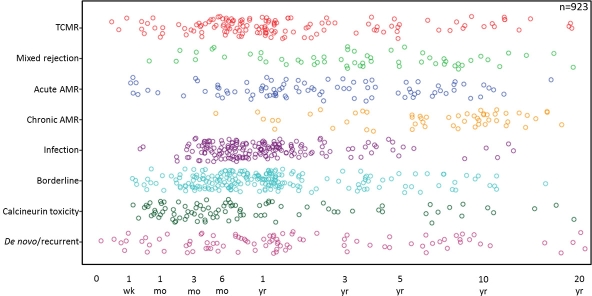A Substantial Fraction of Surveillance Transplant Biopsies Have Clinically Actionable Findings
1Pathology, Michigan Medicine, Ann Arbor
2Nephrology, Michigan Medicine, Ann Arbor.
Meeting: 2018 American Transplant Congress
Abstract number: A141
Keywords: Biopsy, Graft function, Kidney transplantation, Protocol biopsy
Session Information
Session Name: Poster Session A: Kidney Complications: Late Graft Failure
Session Type: Poster Session
Date: Saturday, June 2, 2018
Session Time: 5:30pm-7:30pm
 Presentation Time: 5:30pm-7:30pm
Presentation Time: 5:30pm-7:30pm
Location: Hall 4EF
Background: Surveillance biopsies in renal transplant recipients may detect subclinical disease that affects graft longevity. At our transplant center, most patients with stable allograft function are biopsied at 3, 6, and 12 months after implantation. Indication biopsies are also performed for graft dysfunction and de novo DSA. We sought to determine the rate of clinically significant diagnoses in surveillance biopsies.
Methods: An Access database was populated with pathology reports on all renal biopsies over a 40 month period, obtained from a pathology information system (Soft) and a transplantation clinical database (Otis). Biopsies were categorized by type (native vs. allograft, indication vs. surveillance) and time after transplantation. Natural language diagnoses were standardized. Rejection (antibody and cellular), infection (bacterial and viral), recurrent disease, calcineurin inhibitor toxicity, and obstruction were identified as clinically actionable diagnoses.
Results: 3724 consecutive renal biopsies were reviewed, of which 2294 were non-reperfusion allograft biopsies. At 3, 6, and 12 months after transplant, 13.3%, 16.8%, and 18.8% of surveillance biopsies had clinically actionable diagnoses, compared to 50.3% of indication biopsies (p<0.0001, chi-squared). Cellular rejection diagnoses trended earlier than antibody mediated rejection diagnoses in this population. About 1 in 20 biopsies at or before 6 months showed evidence of viral or bacterial infection, many of which were surveillance biopsies.
Conclusions: Surveillance biopsies in renal transplant recipients frequently identify subclinical renal disease, potentially altering patient management, and are a valuable addition to post-transplant care. The temporal spectrum of rejection related diagnoses in all biopsies is consistent with literature reports. Infectious diagnoses, particularly subclinical polyomavirus infections, are frequent at early timepoints after transplantation.
Fig 1 Selected primary diagnoses for surveillance and indication renal transplant biopsies are plotted together on a logarithmic timescale after transplantation.
CITATION INFORMATION: Shammout A., Naik A., Samaniego M., Farkash E. A Substantial Fraction of Surveillance Transplant Biopsies Have Clinically Actionable Findings Am J Transplant. 2017;17 (suppl 3).
To cite this abstract in AMA style:
Shammout A, Naik A, Samaniego M, Farkash E. A Substantial Fraction of Surveillance Transplant Biopsies Have Clinically Actionable Findings [abstract]. https://atcmeetingabstracts.com/abstract/a-substantial-fraction-of-surveillance-transplant-biopsies-have-clinically-actionable-findings/. Accessed January 7, 2026.« Back to 2018 American Transplant Congress

